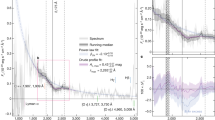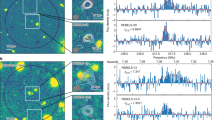Abstract
Dust grains absorb half of the radiation emitted by stars throughout the history of the universe, re-emitting this energy at infrared wavelengths1,2,3. Polycyclic aromatic hydrocarbons (PAHs) are large organic molecules that trace millimetre-size dust grains and regulate the cooling of interstellar gas within galaxies4,5. Observations of PAH features in very distant galaxies have been difficult owing to the limited sensitivity and wavelength coverage of previous infrared telescopes6,7. Here we present James Webb Space Telescope observations that detect the 3.3 μm PAH feature in a galaxy observed less than 1.5 billion years after the Big Bang. The high equivalent width of the PAH feature indicates that star formation, rather than black hole accretion, dominates infrared emission throughout the galaxy. The light from PAH molecules, hot dust and large dust grains and stars are spatially distinct from one another, leading to order-of-magnitude variations in PAH equivalent width and ratio of PAH to total infrared luminosity across the galaxy. The spatial variations we observe suggest either a physical offset between PAHs and large dust grains or wide variations in the local ultraviolet radiation field. Our observations demonstrate that differences in emission from PAH molecules and large dust grains are a complex result of localized processes within early galaxies.
This is a preview of subscription content, access via your institution
Access options
Access Nature and 54 other Nature Portfolio journals
Get Nature+, our best-value online-access subscription
$29.99 / 30 days
cancel any time
Subscribe to this journal
Receive 51 print issues and online access
$199.00 per year
only $3.90 per issue
Buy this article
- Purchase on Springer Link
- Instant access to full article PDF
Prices may be subject to local taxes which are calculated during checkout



Similar content being viewed by others
Data availability
All JWST data are available from the Mikulski Archive for Space Telescopes (https://archive.stsci.edu/) under programme no. 1355. The reduced JWST data products used in this work are available from the TEMPLATES collaboration public data repository, https://github.com/jwst-templates. This paper makes use of ALMA data under project code nos. 2016.1.01374.S and 2016.1.01499.S, available from the ALMA science archive (https://almascience.nrao.edu/aq).
Code availability
JWST and ALMA data were reduced using the publicly available pipeline software for both observatories. Our reduction and analysis scripts for MIRI/MRS data are available from the TEMPLATES collaboration public data repository, https://github.com/jwst-templates.
References
Dole, H. et al. The cosmic infrared background resolved by Spitzer: contributions of mid-infrared galaxies to the far-infrared background. Astron. Astrophys. 451, 417–429 (2006).
Devlin, M. J. et al. Over half of the far-infrared background light comes from galaxies at z>=1.2. Nature 458, 737–739 (2009).
Zavala, J. A. et al. The evolution of the IR luminosity function and dust-obscured star formation over the past 13 billion years. Astrophys. J. 909, 165 (2021).
Kwok, S. & Zhang, Y. Mixed aromatic-aliphatic organic nanoparticles as carriers of unidentified infrared emission features. Nature 479, 80–83 (2011).
Rigopoulou, D. et al. The properties of polycyclic aromatic hydrocarbons in galaxies: constraints on PAH sizes, charge and radiation fields. Mon. Not. R. Astron. Soc. 504, 5287–5300 (2021).
Li, A. Spitzer’s perspective of polycyclic aromatic hydrocarbons in galaxies. Nat. Astron. 4, 339–351 (2020).
Riechers, D. A. et al. Polycyclic aromatic hydrocarbon and mid-infrared continuum emission in a z > 4 submillimeter galaxy. Astrophys. J. 786, 31 (2014).
Carlstrom, J. E. et al. The 10 Meter South Pole Telescope. Publ. Astron. Soc. Pac. 123, 568 (2011).
Everett, W. B. et al. Millimeter-wave point sources from the 2500 Square Degree SPT-SZ Survey: catalog and population statistics. Astrophys. J. 900, 55 (2020).
Weiß, A. et al. ALMA redshifts of millimeter-selected galaxies from the SPT Survey: the redshift distribution of dusty star-forming galaxies. Astrophys. J. 767, 88 (2013).
Spilker, J. S. et al. ALMA imaging and gravitational lens models of South Pole Telescope—selected dusty, star-forming galaxies at high redshifts. Astrophys. J. 826, 112 (2016).
Spilker, J. S. et al. Ubiquitous molecular outflows in z > 4 massive, dusty galaxies. I. Sample overview and clumpy structure in molecular outflows on 500 pc scales. Astrophys. J. 905, 85 (2020).
Rizzo, F. et al. A dynamically cold disk galaxy in the early Universe. Nature 584, 201–204 (2020).
Peng, B. et al. Discovery of a dusty, chemically mature companion to a z~4 starburst galaxy in JWST ERS data. Astrophys. J. 944, L36 (2023).
De Breuck, C. et al. A dense, solar metallicity ISM in the z=4.2 dusty star-forming galaxy SPT0418-47. Astron. Astrophys. 631, A167 (2019).
Spilker, J. S. et al. Ubiquitous molecular outflows in z > 4 massive, dusty galaxies. II. Momentum-driven winds powered by star formation in the early Universe. Astrophys. J. 905, 86 (2020).
Draine, B. T. et al. Excitation of polycyclic aromatic hydrocarbon emission: dependence on size distribution, ionization, and starlight spectrum and intensity. Astrophys. J. 917, 3 (2021).
Schutte, W. A., Tielens, A. G. G. M. & Allamandola, L. J. Theoretical modeling of the infrared fluorescence from interstellar polycyclic aromatic hydrocarbons. Astrophys. J. 415, 397 (1993).
Joblin, C., Tielens, A. G. G. M., Allamandola, L. J. & Geballe, T. R. Spatial variation of the 3.29 and 3.40 micron emission bands within reflection nebulae and the photochemical evolution of methylated polycyclic aromatic hydrocarbons. Astrophys. J. 458, 610 (1996).
Barker, J. R., Allamandola, L. J. & Tielens, A. G. G. M. Anharmonicity and the interstellar polycyclic aromatic hydrocarbon infrared emission spectrum. Astrophys. J. 315, L61 (1987).
Maltseva, E. et al. High-resolution IR absorption spectroscopy of polycyclic aromatic hydrocarbons in the 3 μm region: role of hydrogenation and alkylation. Astron. Astrophys. 610, A65 (2018).
Imanishi, M., Nakagawa, T., Shirahata, M., Ohyama, Y. & Onaka, T. AKARI IRC infrared 2.5-5 μm spectroscopy of a large sample of luminous infrared galaxies. Astrophys. J. 721, 1233–1261 (2010).
Rich, J. et al. GOALS-JWST: pulling back the curtain on the AGN and star formation in VV 114. Astrophys. J. 944, L50 (2023).
Yamada, R. et al. A relation of the PAH 3.3 μm feature with star-forming activity for galaxies with a wide range of infrared luminosity. Publ. Astron. Soc. Jap. 65, 103 (2013).
Inami, H. et al. The AKARI 2.5-5 micron spectra of luminous infrared galaxies in the local Universe. Astron. Astrophys. 617, A130 (2018).
Sajina, A. et al. Detections of water ice, hydrocarbons, and 3.3 μm PAH in z~2 ULIRGs. Astrophys. J. 703, 270–284 (2009).
Siana, B. et al. Detection of far-infrared and polycyclic aromatic hydrocarbon emission from the cosmic eye: probing the dust and star formation of Lyman break galaxies. Astrophys. J. 698, 1273–1281 (2009).
Smith, J. D. T. et al. The mid-infrared spectrum of star-forming galaxies: global properties of polycyclic aromatic hydrocarbon emission. Astrophys. J. 656, 770–791 (2007).
Lai, T. S. Y., Smith, J. D. T., Baba, S., Spoon, H. W. W. & Imanishi, M. All the PAHs: an AKARI-Spitzer cross-archival spectroscopic survey of aromatic emission in galaxiies. Astrophys. J. 905, 55 (2020).
Chabrier, G. Galactic stellar and substellar initial mass function. Publ. Astron. Soc. Pac. 115, 763–795 (2003).
Jakobsen, P. et al. The Near-Infrared Spectrograph (NIRSpec) on the James Webb Space Telescope: I. Overview of the instrument and its capabilities. Astron. Astrophys. 661, A80 (2022).
Böker, T. et al. The Near-Infrared Spectrograph (NIRSpec) on the James Webb Space Telescope: III. Integral-field spectroscopy. Astron. Astrophys. 661, A82 (2022).
Rieke, G. H. et al. The Mid-infrared instrument for the James Webb Space Telescope, I: introduction. Publ. Astron. Soc. Pac. 127, 584 (2015).
Wells, M. et al. The mid-infrared instrument for the James Webb Space Telescope, VI: the Medium Resolution Spectrometer. Publ. Astron. Soc. Pac. 127, 646 (2015).
Labiano, A. et al. Wavelength calibration and resolving power of the JWST MIRI Medium Resolution Spectrometer. Astron. Astrophys. 656, A57 (2021).
JWST-Templates. GitHub https://github.com/jwst-templates.
Reuter, C. et al. The complete redshift distribution of dusty star-forming galaxies from the SPT-SZ Survey. Astrophys. J. 902, 78 (2020).
Acknowledgements
JWST is operated by the Space Telescope Science Institute under the management of the Association of Universities for Research in Astronomy, Inc., under NASA contract no. NAS 5-03127. ALMA is a partnership of ESO (representing its member states), NSF (USA) and NINS (Japan), together with NRC (Canada), MOST and ASIAA (Taiwan) and KASI (Republic of Korea), in cooperation with the Republic of Chile. The Joint ALMA Observatory is operated by ESO, AUI/NRAO and NAOJ. The National Radio Astronomy Observatory is a facility of the National Science Foundation operated under cooperative agreement by Associated Universities, Inc.
Author information
Authors and Affiliations
Contributions
J.S.S. led data analysis and drafted the main text. K.A.P. and D.L. contributed to data analysis. J.D.T.S. assisted in interpretation of data. J.R.R. and J.D.V. contributed to management of the TEMPLATES programme. All authors contributed to interpretation of the results and editing of the text, and are ordered alphabetically after K.A.P.
Corresponding author
Ethics declarations
Competing interests
The authors declare no competing interests.
Peer review
Peer review information
Nature thanks the anonymous reviewers for their contribution to the peer review of this work. Peer reviewer reports are available.
Additional information
Publisher’s note Springer Nature remains neutral with regard to jurisdictional claims in published maps and institutional affiliations.
Extended data figures and tables
Extended Data Fig. 1 Demonstration of residual MRS data artifact removal process.
Each column shows a 100-channel average from the MRS data cube corresponding to the wavelength ranges indicated at top. The top row shows the original pipeline-processed data. Horizontal stripe features are evident, a manifestation of the so-called ‘shower’ artifacts in MIRI data. The middle row shows the estimated background to be subtracted averaged over the same wavelength range. The bottom row shows the final background-subtracted image. The circles show the region of the cube that was masked during the background estimation due to the presence of real source emission from SPT0418-47. All images are on the same color scale. The 3.3 μm PAH feature is mostly contained within the wavelength range of the third column.
Extended Data Fig. 2 Investigations of possible variations in dust temperature across SPT0418-47.
Using additional ALMA continuum data at rest-frame 120 μm, we calculate the implied changes in Tdust under standard assumptions about the shape of the dust spectral energy distribution. The 120 μm and 160 μm images are shown on a linear min/max color scale, masking pixels detected at S/N<5 in either band, to demonstrate their qualitative similarity. This similarity consequently implies only small changes in Tdust across the source. We use the resolved Tdust map to estimate the implied correction to our ‘default’ assumption of a constant conversion between LIR and 160 μm flux density; the right panel shows that only ≈10% variations are implied, subdominant to other sources of uncertainty in our analysis.
Extended Data Fig. 3 Recovery of variations in LPAH/LIR.
Using mock data with constant LPAH/LIR inserted into signal-free portions of the MRS data cube, we test the extent to which the faintness of the PAH feature and noise properties of the MRS data influence our conclusion that SPT0418-47 shows large variations in LPAH/LIR. Points show individual pixels from several of the mock realizations, while the black dashed line and grey shaded region illustrate the median and 16–84th percentile range of the distribution of all mock simulations. Even in the faintest regions, LPAH/LIR is still recovered to within a factor of ≈2, improving to ±25% in brighter regions.
Supplementary information
Rights and permissions
Springer Nature or its licensor (e.g. a society or other partner) holds exclusive rights to this article under a publishing agreement with the author(s) or other rightsholder(s); author self-archiving of the accepted manuscript version of this article is solely governed by the terms of such publishing agreement and applicable law.
About this article
Cite this article
Spilker, J.S., Phadke, K.A., Aravena, M. et al. Spatial variations in aromatic hydrocarbon emission in a dust-rich galaxy. Nature 618, 708–711 (2023). https://doi.org/10.1038/s41586-023-05998-6
Received:
Accepted:
Published:
Issue Date:
DOI: https://doi.org/10.1038/s41586-023-05998-6
This article is cited by
Comments
By submitting a comment you agree to abide by our Terms and Community Guidelines. If you find something abusive or that does not comply with our terms or guidelines please flag it as inappropriate.



